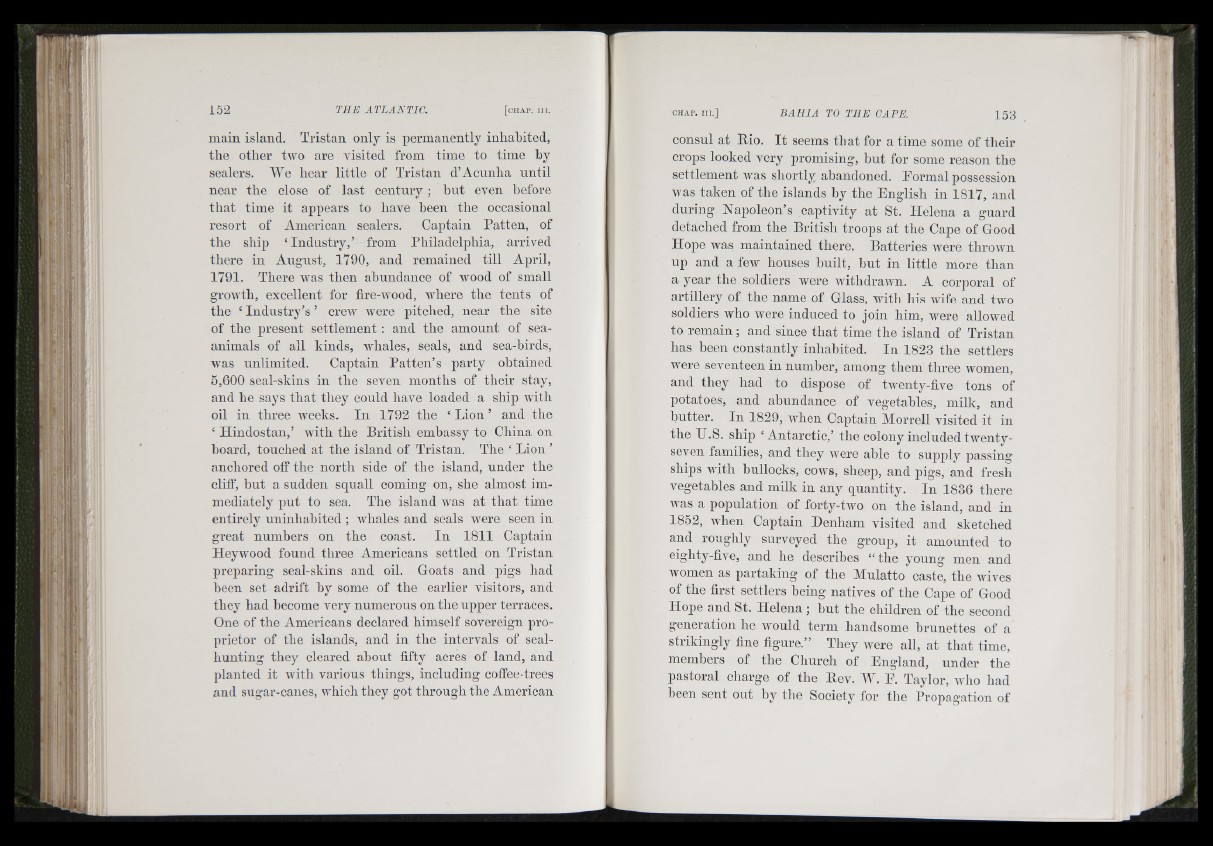
A:
!Niii - 'i:
1 S! V i.ii
main island. Tristan only is permanently inhabited,
the other two are A'isited from time to time hy
sealers. We hear little of Tristan d’Acunlia until
near the close of last century; hut even hefore
that time it appears to have heen the occasional
resort of American sealers. Captain Patten, of
the ship ‘ Industry,’ from Philadelphia, arrived
there in August, 1790, and remained till April,
1791. There ivas then abundance of wood of small
growth, excellent for fire-ivood, wliere the tents of
the ‘ Industry’s ’ crew were pitched, near the site
of the present settlement; and the amount of sea-
animals of all kinds, wliales, seals, and sea-birds,
was unlimited. Captain Patten’s party ohtained
5,600 seal-skins in the seven months of their stay,
and he says that they could have loaded a ship with
oil in three weeks. In 1792 the ‘ Lion ’ and the
‘ Hindostán,’ with the British embassy to China on
hoard, touched at the island of Tristan. The ‘ Lion ’
anchored off the north side of the island, under the
cliff, hut a sudden squall coming on, she almost immediately
put to sea. The island was at that time
entirely uninhahited ; whales and seals were seen in
great numbers on the coast. In 1811 Captain
Hey wood found three Americans settled on Tristan
preparing seal-skins and oil. Goats and pigs had
heen set adrift hy some of the earlier visitors, and
they had become very numerous on the upper terraces.
One of the Americans declared himself sovereign proprietor
of the islands, and in the intervals of seal-
hunting they cleared about fifty acres of land, and
planted it with various things, including coffee-trees
and sugar-canes, which they got through the American
consul at Bio. It seems that for a time some of their
crops looked very promising, but for some reason the
settlement was shortly abandoned. Lormal possession
was taken of the islands by the Lnglish in 1817, and
during Napoleon’s captivity at St. Helena a guard
detached from the British, troops at the Cape of Good
Hope was maintained there. Batteries were thrown
up and a few houses built, but in little more than
a year the soldiers were withdrawn. A corpoi’al of
artillery of the name of Glass, with his wife and two
soldiers who were induced to join him, were allowed
to remain; and since that time the island of Tristan
has been constantly inhabited. In 1823 the settlers
were seventeen in number, among them three women,
and they had to dispose of twenty-five tons of
potatoes, and abundance of vegetables, milk, and
butter. In 1829, when Captain Morrell visited it in
the U.S. ship ‘Antarctic,’ the colony included twenty-
seven families, and they v'ere able to supply passing
ships AA'ith bullocks, cows, sheep, and pigs, and fresh
vegetables and milk in any quantity. In 1836 there
Avas a population of forty-tAvo on the island, and in
1852, when Captain Henham visited and sketched
and roughly surveyed the group, it amounted to
eighty-five, and lie describes “ the young men and
women as partaking of the Mulatto caste, the avI a' c s
of the first settlers being natives of the Cape of Good
Hope and St. Helena; hut the children of the second
generation he Avould term handsome brunettes of a
strikingly fine figure.” They Avere all, at that time,
members of the Church of Lngland, under the
pastoral charge of the Bev. IV. L. Taylor, avIi o had
been sent out hy the Society' for the Propagation of